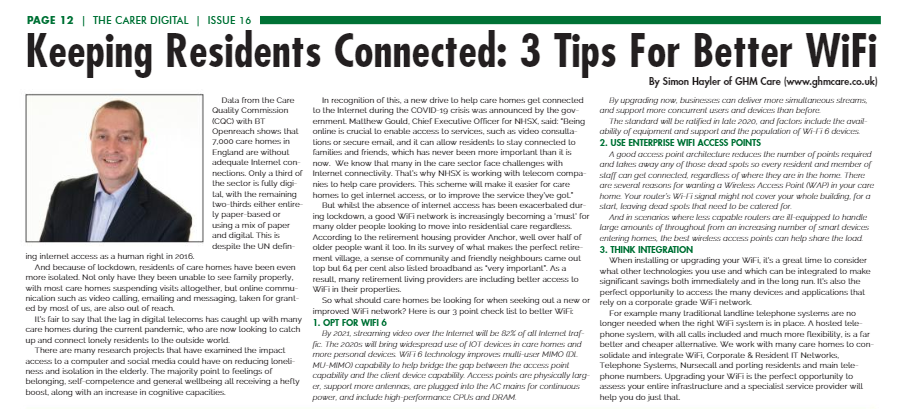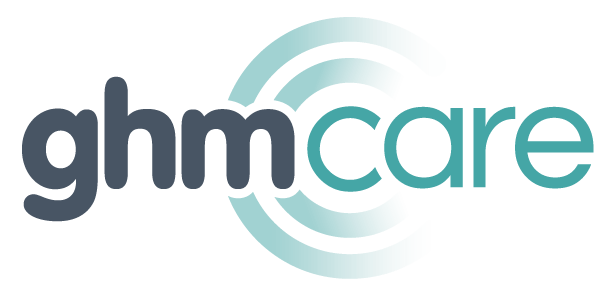
Keeping residents connected: 3 tips for better WiFi
Data from the Care Quality Commission (CQC) with BT Openreach shows that 7,000 care homes in England are without adequate Internet connections. Only a third of the sector is fully digital, with the remaining two-thirds either entirely paper-based or using a mix of paper and digital. This is despite the UN defining internet access as a human right in 2016.
And because of lockdown, residents of care homes have been even more isolated. Not only have they been unable to see family properly, with most care homes suspending visits altogether, but online communication such as video calling, emailing and messaging, taken for granted by most of us, are also out of reach.
It’s fair to say that the lag in digital telecoms has caught up with many care homes during the current pandemic, who are now looking to catch up and connect lonely residents to the outside world.
There are many research projects that have examined the impact access to a computer and social media could have on reducing loneliness and isolation in the elderly. The majority point to feelings of belonging, self-competence and general wellbeing all receiving a hefty boost, along with an increase in cognitive capacities.
In recognition of this, a new drive to help care homes get connected to the Internet during the COVID-19 crisis was announced by the government. Matthew Gould, Chief Executive Officer for NHSX, said: “Being online is crucial to enable access to services, such as video consultations or secure email, and it can allow residents to stay connected to families and friends, which has never been more important than it is now. We know that many in the care sector face challenges with Internet connectivity. That’s why NHSX is working with telecom companies to help care providers. This scheme will make it easier for care homes to get internet access, or to improve the service they’ve got.”
But whilst the absence of internet access has been exacerbated during lockdown, a good WiFi network is increasingly becoming a ‘must’ for many older people looking to move into residential care regardless. According to the retirement housing provider Anchor, well over half of older people want it too. In its survey of what makes the perfect retirement village, a sense of community and friendly neighbours came out top but 64 per cent also listed broadband as “very important”. As a result, many retirement living providers are including better access to WiFi in their properties.
So what should care homes be looking for when seeking out a new or improved care home WiFi network? Here is our 3 point check list to better WiFi:
- Opt for WiFi 6
By 2021, streaming video over the Internet will be 82% of all Internet traffic. The 2020s will bring widespread use of IOT devices in care homes and more personal devices. WiFi 6 technology improves multi-user MIMO (DL MU-MIMO) capability to help bridge the gap between the access point capability and the client device capability. Access points are physically larger, support more antennas, are plugged into the AC mains for continuous power, and include high-performance CPUs and DRAM.
By upgrading now, businesses can deliver more simultaneous streams, and support more concurrent users and devices than before.
The standard will be ratified in late 2020, and factors include the availability of equipment and support and the population of Wi-Fi 6 devices.
- Use Enterprise WiFi Access Points
A good access point architecture reduces the number of points required and takes away any of those dead spots so every resident and member of staff can get connected, regardless of where they are in the home. There are several reasons for wanting a Wireless Access Point (WAP) in your care home. Your router’s Wi-Fi signal might not cover your whole building, for a start, leaving dead spots that need to be catered for.
And in scenarios where less capable routers are ill-equipped to handle large amounts of throughout from an increasing number of smart devices entering homes, the best wireless access points can help share the load.
- Think integration
When installing or upgrading your WiFi, it’s a great time to consider what other technologies you use and which can be integrated to make significant savings both immediately and in the long run. It’s also the perfect opportunity to access the many devices and applications that rely on a corporate grade WiFi network.
For example many traditional landline telephone systems are no longer needed when the right WiFi system is in place. A hosted telephone system, with all calls included and much more flexibility, is a far better and cheaper alternative. We work with many care homes to consolidate and integrate WiFi, Corporate & Resident IT Networks, Telephone Systems, Nursecall and porting residents and main telephone numbers. Upgrading your WiFi is the perfect opportunity to assess your entire infrastructure and a specialist service provider will help you do just that.
